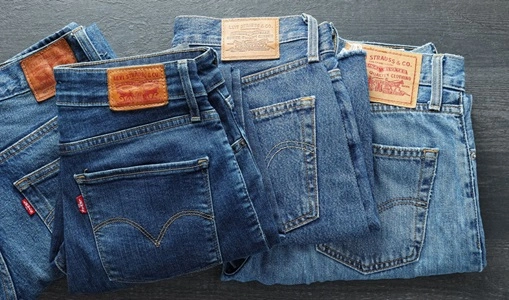Levi’s jeans are renowned worldwide for their quality, durability, and timeless style. However, the brand’s popularity has led to a proliferation of counterfeit products in the market. To ensure you’re purchasing authentic Levi’s jeans, consider the following detailed guidelines:
1. Examine the Rear Leather Patch
- Design and Content: Authentic Levi’s jeans feature a leather patch on the back waistband, displaying the iconic Two Horse Pull logo, the text “LEVI STRAUSS & CO.,” “SAN FRANCISCO, CAL.,” and “ORIGINAL RIVETED.” The patch also includes the jeans’ style number (e.g., 501) and waist and length measurements. Counterfeit jeans may have patches with incorrect information, misspellings, or poor-quality printing.
- Material and Color: The leather patch on genuine Levi’s is typically a consistent shade of brown. Variations in color or material quality can indicate a fake.

2. Inspect the Red Tab
- Logo Text: The red tab on the right back pocket should have “LEVI’S” stitched in white, with precise and even lettering. Jeans produced before 1971 feature a capital “E” (“LEVI’S”), while those made after 1971 have a lowercase “e” (“Levi’s”). Some authentic pairs may display only the ® symbol, which is normal.
- Stitching Quality: Ensure the red tab is neatly stitched into the pocket seam. Uneven stitching or misalignment can be signs of counterfeit products.
3. Analyze the Rivets and Buttons
- Rivet Details: Authentic Levi’s rivets are made of high-quality copper and are embossed with “LS&CO-SF,” standing for Levi Strauss & Co. San Francisco. Counterfeit jeans may have smooth or poorly detailed rivets.
- Button Engravings: The front button of genuine Levi’s jeans typically features “Levi Strauss & Co. S.F. Cal.” on the front and a three-digit code on the back, indicating the factory of origin. Absence of these details can suggest a fake.
4. Check the Stitching and Arcuate Design
- Stitching Quality: Authentic Levi’s jeans exhibit uniform, tight stitching without loose threads. Inconsistent stitching patterns may indicate counterfeit production.
- Arcuate Stitching: The back pockets should display the distinctive arcuate stitching design, resembling a double arch or “batwing.” This design is a trademark of Levi’s and should be symmetrical and well-executed.
5. Review the Care Tag and Inseam
- Care Tag Presence: Levi’s began adding care tags in the 1970s. The absence of a care tag in newer jeans can be a red flag for counterfeits.
- Inseam Stitching: Most Levi’s jeans made before the mid-1980s feature a single felled inseam, a single stitch running down the inner thigh. Modern jeans typically have double-stitched inseams.
6. Assess the Overall Quality and Fit
- Material Quality: Authentic Levi’s jeans are made from high-quality denim that feels substantial and durable. Inferior fabric or a lightweight feel can indicate a counterfeit product.
- Fit and Construction: Genuine Levi’s are known for their consistent fit and superior construction. Uneven hems, mismatched patterns, or asymmetry are signs of poor-quality fakes.
7. Purchase from Authorized Retailers
- Authorized Sellers: To minimize the risk of purchasing counterfeit jeans, buy from official Levi’s stores or authorized retailers. Levi’s official website provides a store locator to find legitimate sellers.
8. Be Cautious of Unusually Low Prices
- Price Consistency: Significantly discounted prices, especially from unauthorized sellers, can be a red flag for counterfeit products. Authentic Levi’s jeans are priced consistently across official outlets.
By meticulously examining these aspects, you can confidently determine the authenticity of Levi’s jeans and ensure you’re investing in genuine, high-quality denim.

